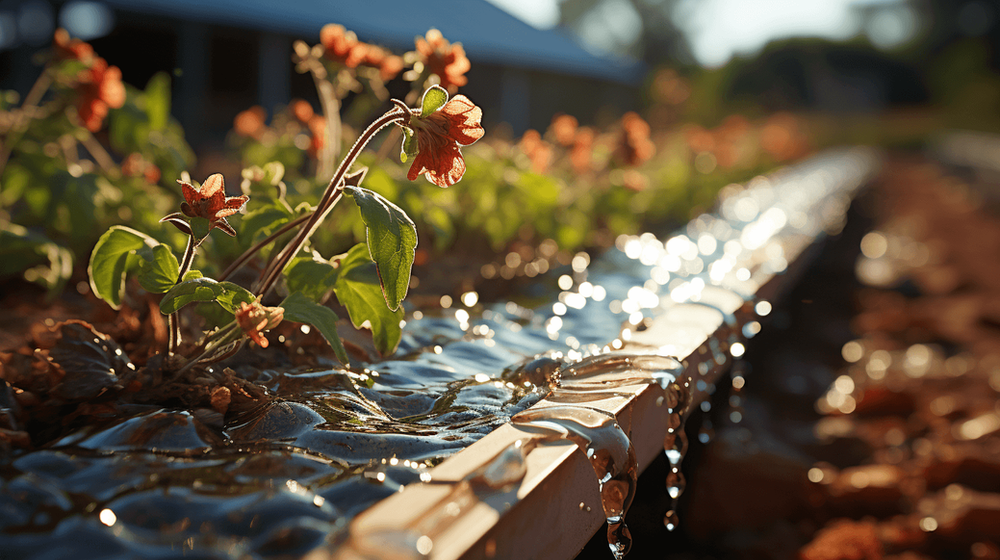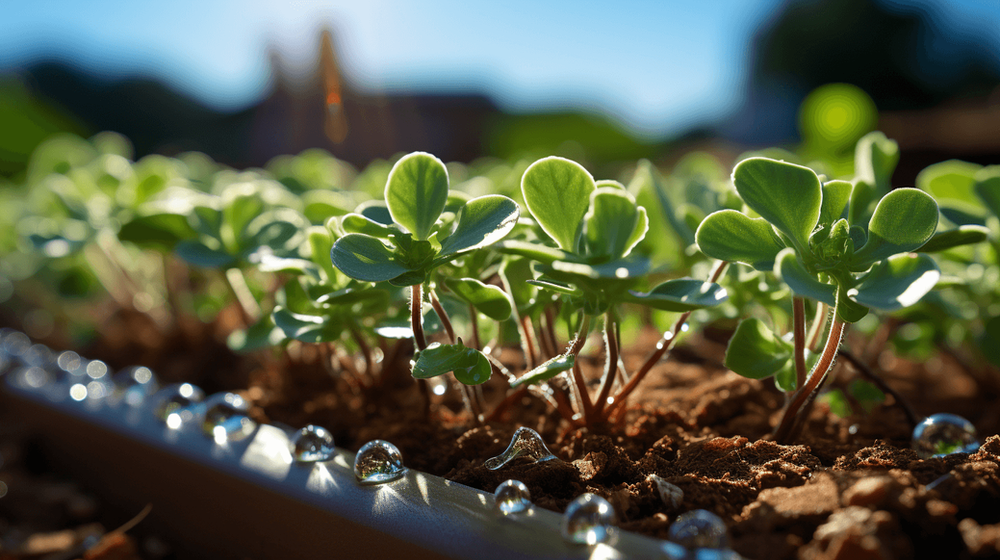
Looking to optimize your drip irrigation in the arid climate of Arizona? Understanding how to properly water your garden can significantly lessen water wastage and cultivate healthier plants.
In this guide, we discuss key factors to consider for the optimal watering duration, and seasonal adjustments and provide effective tips for the efficient use of drip irrigation systems. Ready to master the art of mindful watering? Let’s dive in!
Key Takeaways
- Proper watering duration is crucial for the success of drip irrigation in Arizona, as it ensures efficient water usage and healthy plant growth.
- Factors to consider for determining optimal watering duration include plant type, climate conditions, soil type, drainage capacity, and landscape size. Monitoring soil moisture levels using smart irrigation controllers or moisture sensors is vital.
- Seasonal variations in watering needs require adjusting watering durations accordingly. Spring and summer typically require longer durations while fall and winter need shorter durations.
- Tips for efficient watering with drip irrigation include adjusting duration based on plant needs, utilizing smart irrigation controllers, monitoring soil moisture levels regularly, and incorporating mulch to retain moisture
Understanding Optimal Watering Duration for Drip Irrigation in Arizona
Proper watering duration is crucial for the success of drip irrigation in Arizona, as it ensures efficient water usage and healthy plant growth.
Importance of proper watering duration
Proper watering duration in drip irrigation holds the key to a thriving Arizona landscape. It’s essential not just for plant health but also for optimal water efficiency and conservation, crucial in our state renowned for its arid disposition.
Striking the right balance encourages deep root growth, fostering resilient plants that can withstand dry periods. Watering too little can leave plants parched while over-watering squanders this precious resource and might even drown your verdant friends.
A skimp or splurge on the clock during drip irrigation run times – typically lasting 2 hours or more – profoundly impacts not only your lush oasis but also plays a part in addressing global environmental issues like water management.
Factors to consider for determining the optimal watering duration
When determining the optimal watering duration for your drip ,irrigation system in Arizona, there are several important factors to consider. Firstly, you need to take into account the type of plants or vegetation you have in your landscaping.
Different plants have different water requirements, so it’s crucial to understand their specific needs. Secondly, consider the climate and weather conditions in Arizona. The hot and arid climate means that plants may require more frequent watering and longer durations during periods of high temperatures.
Another factor is soil type and drainage capacity. Sandy soils drain quickly and may require shorter watering durations but more frequent sessions, whereas clayey soils retain moisture better and may need longer watering durations but less frequently.
Additionally, the size of your landscape area plays a role; larger areas may require longer watering durations to ensure adequate coverage.
Monitoring soil moisture levels is vital in determining when to water again. Make use of smart irrigation controllers or invest in moisture sensors to accurately measure soil moisture levels and adjust your watering schedule accordingly.
Seasonal variations in watering needs
Watering needs vary throughout the seasons in Arizona, and it’s important to adjust your watering duration accordingly. During spring, when temperatures are mild, plants require less water compared to the scorching summer months.
As summer approaches and temperatures soar, plants need longer watering durations to combat the heat and prevent dehydration. In fall, as temperatures start to cool down again, you can gradually reduce the watering duration.
Finally, during winter when rainfall is more abundant and cooler temperatures prevail, plants generally require less frequent watering sessions. By understanding these seasonal variations in watering needs, you can ensure that your drip irrigation system provides adequate hydration for your landscape year-round while promoting water efficiency.

Guidelines for Watering Duration in Different Seasons
Spring, summer, fall, and winter all have different watering requirements. Adjusting your watering duration for each season is crucial in ensuring the health of your plants and conserving water.
Spring watering duration
During the spring season in Arizona, it is crucial to understand the optimal watering duration for your drip irrigation system. As the weather starts to warm up and plants begin their active growth phase, they require adequate hydration to thrive.
According to landscape watering guidelines, it is recommended to run your drip irrigation system for a minimum of 2 hours or more during each watering session. This ensures that the water reaches deep into the root zone, promoting healthy plant development.
However, it’s important to consider ,professional advice, and factors such as soil type and plant species when determining the exact watering duration. By following these guidelines, you can ensure that your plants receive the right amount of moisture during this critical time of year.
Summer watering duration
During the hot and dry summer months in Arizona, it’s crucial to ensure your plants receive adequate hydration. To help them thrive and withstand the scorching temperatures, drip irrigation should be done for an optimal duration of 2-6 hours.
This timeframe allows enough water to seep into the soil without wasting excessive amounts. Remember that frequent schedule changes are recommended to maximize water savings and maintain plant health with drip ,irrigation systems.
Additionally, keep in mind that less water is required during cooler or rainy weather conditions. By following these guidelines for summer watering duration, you can keep your landscape lush and vibrant while conserving precious water resources.
Fall watering duration
During the fall season, it is crucial to adjust your watering duration for drip irrigation in Arizona to meet the changing needs of your landscape. As temperatures start to cool down and plants go into a dormant state, they require less water compared to the hot summer months.
However, it’s important not to completely stop watering as plants still need hydration.
A general guideline for fall watering duration is approximately 1-2 hours per session, depending on the specific needs of your landscape. This allows for deep penetration of water into the soil, promoting healthy root growth and ensuring proper moisture levels are maintained.
Remember that factors such as plant type, soil type, and weather conditions can also influence how much water your landscape requires. It’s always a good idea to monitor soil moisture levels regularly using moisture meters or conducting a simple finger test.
Winter watering duration
During the winter months in Arizona, it is essential to adjust your watering duration for drip irrigation systems to ensure optimal plant health. With cooler temperatures and reduced evaporation rates, plants require less water compared to other seasons.
It is recommended to reduce the watering duration by about 20-30% during this time. In general, aim for a run time of around 1-2 hours per watering session, depending on the specific needs of your landscape.
This will provide sufficient hydration while avoiding overwatering and unnecessary water usage. Remember, proper water management is crucial for both plant health and environmental conservation.

Tips for Efficient Watering with Drip Irrigation
Adjust watering duration based on plant needs to ensure efficient water usage. Use smart irrigation controllers to automate the process and monitor soil moisture levels regularly. Incorporate mulch around plants to retain moisture in the soil and reduce evaporation.
Efficient watering with drip irrigation promotes healthier plants while conserving water resources in Arizona’s arid climate.
Adjusting watering duration based on plant needs
To ensure the health and vitality of your plants, it’s crucial to adjust the watering duration based on their specific needs. Different plants have different water requirements, so it’s important to tailor your drip irrigation system accordingly.
For instance, drought-tolerant plants like cacti and succulents require less frequent watering compared to more water-hungry flowers and vegetables. By understanding the specific needs of each plant in your landscape, you can optimize their watering duration for maximum growth.
Furthermore, monitoring the soil moisture levels is key in adjusting watering duration. By regularly checking the moisture content with a soil moisture meter or by performing a simple finger test, you can determine whether it’s time to water or if you need to prolong or shorten the watering session.
Additionally, consider installing smart irrigation controllers that use weather data and real-time information to automatically adjust watering schedules based on current conditions.
Utilizing smart irrigation controllers
Smart irrigation controllers are a game-changer when it comes to optimizing your drip irrigation system in Arizona. These intelligent devices use advanced technology to monitor weather conditions and soil moisture levels and even adjust watering schedules accordingly.
With a smart irrigation controller, you can say goodbye to manual adjustments and guesswork. It takes the guesswork out of watering by automatically adjusting run times based on real-time data.
This not only ensures that your plants receive just the right amount of water they need but also helps you save water and reduce costs. So, if you want a hassle-free and efficient way to manage your drip irrigation system, investing in a smart irrigation controller is definitely worth considering.
Monitoring soil moisture levels
To ensure optimal water usage and plant health in your Arizona landscape, it is crucial to monitor soil moisture levels regularly. Checking the moisture content of the soil helps you determine when and how much water to provide through drip irrigation.
A simple way to gauge soil moisture is by using a moisture meter or by conducting a touch test. Insert the probe or your finger into the soil, about 4-6 inches deep, near the plant’s root zone.
If it feels moist, you can delay watering for some time; if it feels dry, it’s time to irrigate. Remember that different plants have varying water requirements, so understanding their individual needs is essential for efficient watering management.
Incorporating mulch to retain moisture
Mulching is a simple yet effective technique to retain moisture in your landscape when using drip irrigation in Arizona. By applying a layer of organic mulch, such as wood chips or straw, around your plants and trees, you create a barrier that helps prevent evaporation and keeps the soil cool.
This means less water is lost to the hot Arizona sun, allowing it to penetrate deeper into the root zone where plants need it most. Research shows that mulched areas can reduce water loss by up to 70 percent compared to unmulched areas.
Additionally, mulch helps suppress weed growth, which competes with your plants for water resources. So not only does incorporating mulch save you time and effort on weeding but also ensures efficient water usage for your landscape all year round.

Conclusion
In conclusion, understanding the optimal watering duration for drip irrigation in Arizona is essential for maintaining healthy and thriving plants. By following seasonal guidelines, adjusting watering durations based on plant needs, utilizing smart irrigation controllers, monitoring soil moisture levels, and incorporating mulch to retain moisture, you can ensure efficient water usage and promote sustainable landscaping practices.
With this comprehensive guide at your disposal, you’ll be equipped to make informed decisions about your landscape’s watering needs and contribute to water conservation efforts in Arizona.

